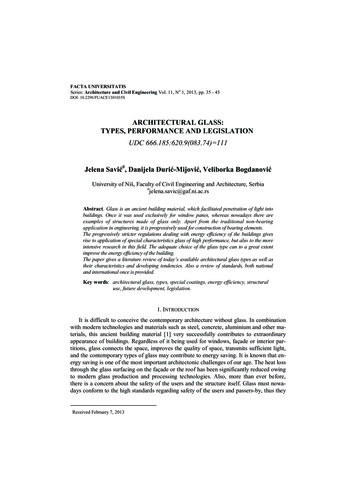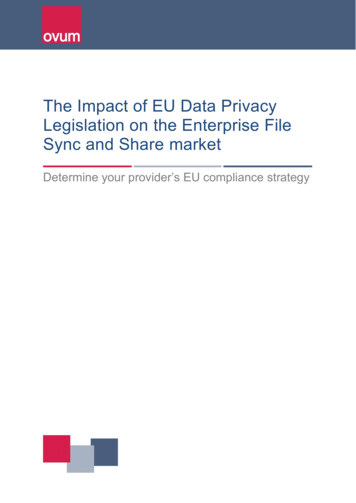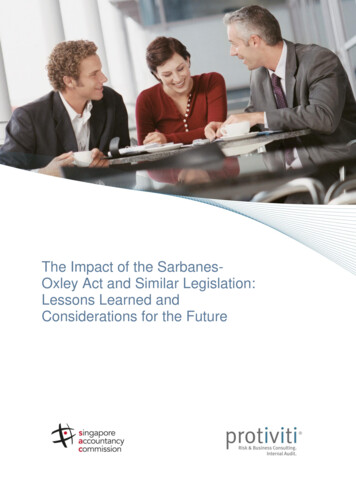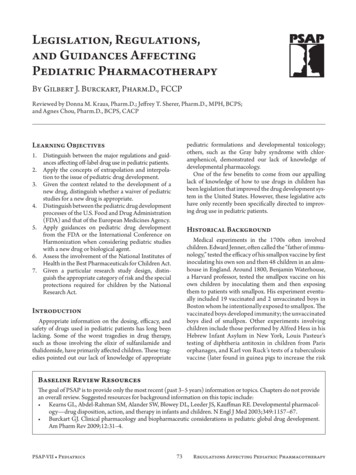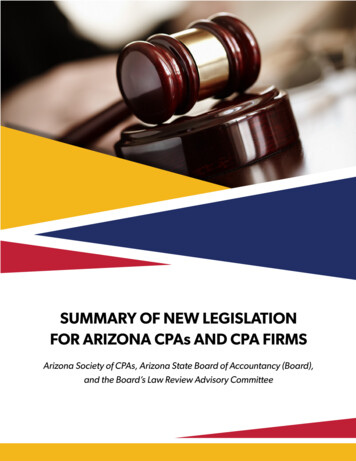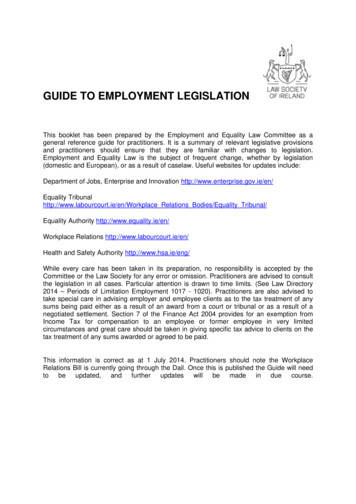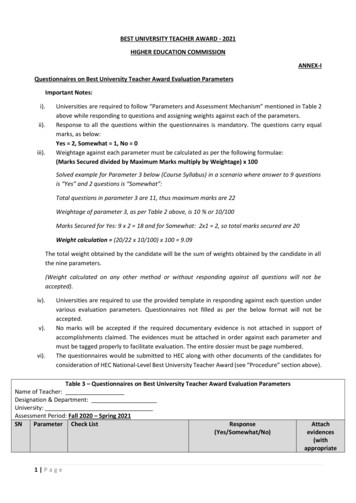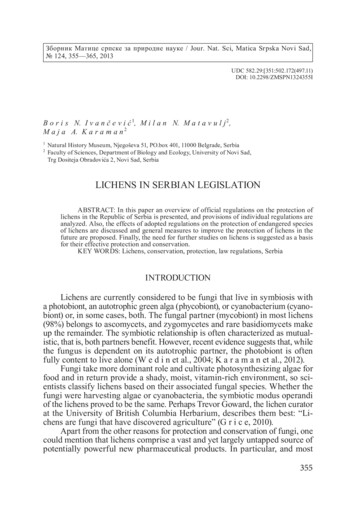
Transcription
Зборник Матице српске за природне науке / Jour. Nat. Sci, Matica Srpska Novi Sad, 124, 355—365, 2013UDC 582.29:[351:502.172(497.11)DOI: 10.2298/ZMSPN1324355IB o r i s N. I v a n č e v i ć 1, M i l a n N. M a t a v u l j 2 ,M a j a A. K a r a m a n 212Natural History Museum, Njegoševa 51, PO.box 401, 11000 Belgrade, SerbiaFaculty of Sciences, Department of Biology and Ecology, University of Novi Sad,Trg Dositeja Obradovića 2, Novi Sad, SerbiaLICHENS IN SERBIAN LEGISLATIONABSTRACT: In this paper an overview of official regulations on the protection oflichens in the Republic of Serbia is presented, and provisions of individual regulations areanalyzed. Also, the effects of adopted regulations on the protection of endangered speciesof lichens are discussed and general measures to improve the protection of lichens in thefuture are proposed. Finally, the need for further studies on lichens is suggested as a basisfor their effective protection and conservation.KEY WORDS: Lichens, conservation, protection, law regulations, SerbiaINTRODUCTIONLichens are currently considered to be fungi that live in symbiosis witha photobiont, an autotrophic green alga (phycobiont), or cyanobacterium (cyanobiont) or, in some cases, both. The fungal partner (mycobiont) in most lichens(98%) belongs to ascomycets, and zygomycetes and rare basidiomycets makeup the remainder. The symbiotic relationship is often characterized as mutualistic, that is, both partners benefit. However, recent evidence suggests that, whilethe fungus is dependent on its autotrophic partner, the photobiont is oftenfully content to live alone (W e d i n et al., 2004; K a r a m a n et al., 2012).Fungi take more dominant role and cultivate photosynthesizing algae forfood and in return provide a shady, moist, vitamin-rich environment, so scientists classify lichens based on their associated fungal species. Whether thefungi were harvesting algae or cyanobacteria, the symbiotic modus operandiof the lichens proved to be the same. Perhaps Trevor Goward, the lichen curatorat the University of British Columbia Herbarium, describes them best: “Lichens are fungi that have discovered agriculture” (G r i c e, 2010).Apart from the other reasons for protection and conservation of fungi, onecould mention that lichens comprise a vast and yet largely untapped source ofpotentially powerful new pharmaceutical products. In particular, and most355
importantly for modern medicine, they represent an unlimited source of polysaccharides with anti-tumor and immunostimulatory properties. Most ofthem, if not all, contain biologically active polysaccharides that differ inchemical compositions, most of them belonging to the group of β-glucanswhich have specific chemical linkages that are needed for their anti-tumoraction (S h i b a t a et al., 1968; N i s h i k a w a, 1969, O l a f s d o t t i r and I n g ó l f s d o t t i r, 2001).Unfortunately, the notion that lichen species, just like other organisms onour planet, can become endangered has been neglected so far. Moreover, awareness of the risk of lichen species reduction and the fact that some species havealready disappeared has come too late and many anthropogenic lichen desertshave already been reported worldwide (G i l b e r t, 1971; H e n d e r s o n, 1987;D a s, 2013), as well as in Serbia (K u y u n d h i c y et al., 1998 a,b; M a t a v u l j et al., 1998; C v i j a n et al., 2008).Generally, it is considered that the main reasons for categorization oflichens as threatened organisms are disappearance and contamination of theirhabitats primarily caused by humans, due to pollution of the atmosphere, industrialized agriculture, unfavorable forestry practices and anthropogenic alterations of large habitat areas. All of these issues have led to the degradation oflichen habitats.LICHENS AS POLLUTION MONITORSIn 1859 L.H. Grindon attributed the declining lichen flora of South Lancashire to increasing air pollution and, in 1866, W. Nylander concluded fromthe studies conducted in Paris that lichens might serve as practical indicatorsof air quality. Subsequent studies from all over the world, which were publishedin over 500 scientific publications, vindicated Nylander’s views (H a w k s w o r t h and R o s e, 1970).In 1912 it was appreciated that the lichen vegetation on trees in urbanareas could be divided into zones easily recognizable in the field. Three orfour zones can be most commonly distinguished: (1) an inner “lichen desert”with no lichens, or at least no foliose and fruticose species, (2) an intermediate“struggle” or “transition” zone where foliose and fruticose species begin toappear but are poorly developed (often divided into an “inner” and “outer”zone where foliose and fruticose species, respectively, first appear), and (3) anouter “normal” zone with lichen vegetation unaffected by pollution.The lichen growth can be affected by different gaseous air pollutantssuch as: high sulfur dioxide concentration, carbon compounds in smoke, fluorides, car fumes (carbon monoxide, oxides of nitrogen, lead containing compounds, hydrocarbons) and dust, photo-chemical smog (ozone, peroxyacetylnitrate, nitrogen oxides etc.), heavy metals (iron, lead, zinc, and copper), radioactive isotopes of metals (radionuclides), agricultural chemicals (pesticides, especially fungicides, fertilizers) (H a w k s w o r t h, 1971, L o p p i andC o r s i n i, 1995).356
Lichenoflora in Vojvodina, including bank region of the River Tamiš andthe Danube-Tisza-Danube Canal hydrosystem has been explored randomly(K u y u n j i c y et al., 1998a,b; K u j u n d ž i ć and M a t a v u l j, 1998; M a t a v u l y et al., 1998; M a t i j a š e v i ć, 1988), and more systematically withinthe study of former Yugoslavia lichen flora (K u š a n, 1953; M u r a t i, 1992,1993; M a t a v u lj and Đ u r đ e v i ć, 2005).After collection of a substantial body of knowledge on the vulnerabilityof lichens in the last decade of the twentieth century, lichens slowly began tobe incorporated in nature protection programs, and the frameworks of actionsthat address their conservation became more formal and recognized (to a greater or lesser extent) by some states. At that time, the need to introduce somekind of control was also recognized in the Republic of Serbia. The presentpaper provides an overview of legislation in Serbia regarding the protection oflichens in nature. The main objective of this paper was to present a chronological review of regulations on the protection of lichens, analyze the effectsof enacted regulations on the population of lichens, and propose the ways toimprove their conservation and protection in the future.Regulations that apply only indirectly to macromycetes, including lichens,such as laws related to forestry, national parks and similar (e.g. laws regardingnature conservation but not explicitly mentioning lichens) were not considerednor were the laws governing other areas related to lichens, such as regulationsfocused on pharmaceutical or food industry, or the protection of materials,medical and related aspects.The basic condition for the preservation of lichens (or any other organism)is increased awareness of existing problems which requires in depth study,rapid and satisfactory taxonomic inventories, and extensive ecological andchorological studies. Although mycological and lichenological research datahave been collected in the Republic of Serbia for nearly a century, these studies were done randomly and non-systematically: driven by individual enthusiasm rather than as a part of a systematic research project; thus, these dataare not sufficient to guide the decisions and regulations for the protection andpreservation of lichens (I v a n č e v i ć, 1995).Adequate protection of lichens can only be established based on solidand reliable scientific data collected through systematic and long-term scientific studies. It is therefore necessary to make a substantial investment in basiclichenological research. Another necessary condition for determining the stateof endangered lichens is careful monitoring of population sizes, abundance,diversity and distribution over a long period, using standardized methodologies. Then, based on the collected data a Red List of endangered lichens canbe created, preferably using generally accepted IUCN classifications (IUCN,2001). However, it may be inappropriate to delay protective measures until theexpected optimum level of knowledge about the population of lichens andother macromycets is reached (M a t a v u l j et al., 1998; M a t a v u l j andK a r a m a n, 2004).The material used in this paper consists of legal provisions of the Republic of Serbia (laws and other regulations) relating to environmental protection:357
Закон о заштити природе. Службени гласник Социјалистичке Републи кеСрбије бр. 29, 1988 – [Nature conservation law, 1988]; Одлука о стављањупод заштиту биљних врста као природних реткости. Службени гла сникСоцијалистичке Републике Србије 11, 17. 03. 1990 – [Decision on puttingplant species under protection as natural rarities, 1990]; Одлука о изменамаи допунама одлуке о стављању под заштиту биљних врста каоприродних реткости. Службени гласник СРС 49, 15. 08. 1991 – [Decisionon amending the decision on putting plant species under protection as naturalrarities, 1991] – Закон о заштити животне средине. Службени гласникРепублике Србије 66/1991, 83/1992, 53/1993, 67/1993, 48/1994 и 53/1995 –[Environmental protection law, 1991]; Уредба о заштити природних рет ко сти, Службени гласник Републике Србије 50, 09. 07. 1993 – [Regulation onthe protection of natural rarities, 1993]; Наредба о контроли коришћења ипро мета дивљих биљних и животињских врста. Службени гласник Ре публике Србије 50, 09. 07. 1993. и 36/1994 – [Directive on control of use andtrade of wild plant and animal species, 1993]; Наредба о стављању под кон тро лу коришћења и промета дивљих биљних и животињских врста. Слу жбени гласник Републике Србије 16, 05. 04. 1996. и 44/1996 – [Directive oncontrol of use and trade of wild plant and animal species, 1996]; На редба остављању под контролу коришћења и промета дивљих биљних и живо тињ ских врста. Службени гласник Републике Србије 17, 07. 04. 1999 –[Directive on control of use and trade of wild plant and animal species, 1999];Закон о заштити животне средине. Службени гласник Републике Срби је135/2004 и 36/2009 – [Environmental protection law, 2004]; Уредба о ста вљању под контролу коришћења и промета дивље флоре и фауне. Слу жбени гласник Републике Србије 31/2005, 45/2005-испр., 22/2007, 38/2008,9/2010 – [Regulation on putting the use and trade of wildlife under control,2005]; Convention on the conservation of European wildlife and natural habitats – the Bern convention (the Republic of Serbia signed and ratified thisconvention on 9 January 2008 and implementation began on May 1, 2008); Законо заштити природе. Службени гласник Републике Србије 36, 12.05.2009и 88/2010 – [Nature conservation law, 2009]; Правилник о проглашењу иза штити строго заштићених и заштићених дивљих врста биљака, жи во тиња и гљива. Службени гласник Републике Србије 5, 05. 02. 2010 –[Regulation on the proclamation and protection of strictly protected and protected wild species of plants, animals and fungi, 2010]. Listed legal provisionsof the Republic of Serbia (laws and other regulations) were reviewed and analyzed in this paper.OVERVIEW OF REGULATIONS ON THE PROTECTIONOF LICHENS IN REPUBLIC OF SERBIA- Nature Conservation Law (Službeni Glasnik RS, br. 29/88), Decisionon putting plant species under the protection as natural rarities (SlužbeniGlasnik br. 11/90, March 17, 1990), and Decision on amending the decision on358
putting under the protection of plant species as natural rarities (Službeni Gla snik RS, br. 49/91, August 15, 1991), by alteration (amendments) of the text ofthe Decision of 1990, as well as The Environmental protection law (SlužbeniGla snik RS, br. 66/91, 83/92, 53/93, 67/93, 48/94 and 53/95), does not considermushrooms or lichens. Regulation on the Protection of natural rarities (Slu žbeni Glasnik RS br. 50/93, June 9, 1993) and the Directive on control of the useand trade of wild plant and animal species (Službeni Glasnik RS, br. 50/93, June9, 1993 and 36/94), placed no lichen species under control. The Directive oncontrol of the use and trade of wild plant and animal species (Službeni GlasnikRS, br. 16/96, April 5, 1996 and 44/96) and the Directive on control of the useand trade of wild plant and animal species (Službeni Glasnik RS, br. 17/99,April 7, 1999) placed none of the lichen species under protection, too.The Republic of Serbia signed and ratified the Convention on the conservation of European wildlife and natural habitats – Bern convention, on January9, 2008 and provisions began to be implemented on May 1, 2008, without anyspecial reference to the lichens. Also, Environmental protection law, (SlužbeniGlasnik RS, br. 135/04 and 36/09), under the latest amendments to this Regulation (from 2010), put none of the lichen species under protection. Natureconservation law (Službeni Glasnik RS, br. 36/09, May 12, 2009, and 88/10),and Regulation on proclamation of putting the use and trade of wildlife undercontrol (Službeni Glasnik RS, br. 31/05, 45/05, 22/07, 38/08, 9/10), provided abasis for lichen protection because the latest amendments of this Regulation(from 2010) included a list of the following species of lichens (Tab. 1), orstrictly protected lichen species (Tab. 2).Tab. 1. – List of protected lichen species according to the Regulation on the declaration andprotection of protected and strictly protected wild species of plants, animals and fungi. SlužbeniGlasnik RS, br 5/10.Latin nameAuthorsEnglish name*Serbian nameTrue Iceland lichen,прави исландскиCetraria islandica(L.) Ach., 1803Iceland cetraria lichen лишајOakmoss lichen,шљивин лишај,Evernia prunastri(L.) Ach., 1810Ring lichenхрастов лишајPurper geweimos,пурпурни лишајPseudevernia furfuracea(L.) Zopf, 1903Тreemoss, Tree lichenUsnea spp. (Excluded Strictly Dill. ex Adans., Old Man's Beard,дедина брада1763Beard Lichenprotected Usnea species)*English and Serbian names and authors, added in the Table for this edition, are missing in theoriginal List in the text of Law Regulation359
Tab. 2. – List of strictly protected lichen species according to the Regulation on the declarationand protection of protected and strictly protected wild species of plants, animals and fungi.Službeni Glasnik RS, br. 5/10.Latin nameAlectoria sarmentosaAnaptychia crinalisCetrelia cetrarioidesAuthors(Ach.) Ach. , 1810(Schleich.) Vĕzda,1977(Duby) W.L.Culb. &C.F.Culb.Serbian nameEnglish name*Witch’s hairвештичја косаFringed eyed centipedeресасти лишајlichenGiant shield lichenштитасти лишајRing lichenPink-eyed shinglelichenзгрудвани малипихтијасти лишајмехурасти црнипихтијасти лишајпрстенасти лишајцреполикиружичасти лишајElegant script lichenисписани лишајCollema fragrans(Sm.) Ach. , 1814Clustered mini-jellylichenCollema nigrescens(Hudson) DC.Blistered jelly lichenEvernia divaricata(L.) Ach., 1810Fuscopannaria saubinetii (Mont.) P.M. Jørg.,Syn. Vahliella saubinetii 2008(Borrer ex Sm.) Ach.,Graphis elegans1814Heterodermia speciosa(Wulfen) Trevis.,1868Hypogymnia vittata(Ach.) ParriqueLempholemma polyanthesLeprocaulon microscopicumLeptogium hildenbrandiiSyn. Leptogium papillosum(Bernh.) Malme,1924(Vill.) Gams ex D.Hawksw.(Garov.) Nyl. 1856(de Lesd.) C.W.Dodge, 1933Leptogium saturninum(Dicks.) Nyl., 1856Powdered shield fringeресасто-штитастиlichen, Powderedстоноги лишајcentipede lichenувијено-тракастиVitt tube ubbly skin lichenлишајMealy lichenбрашњави лишајHildenbrand’s skinlichenхилденбрандовкожасти лишајSaturn skin lichen,Bearded jellyskinдлакави �илишајLeptogium teretiusculum (Wallr.) ArnoldTerete skin lichenLetharia vulpina(L.) Hue, 1899Wolf lichen,Timber wolfLobaria amplissima(Scop.) Forss., 1883Lungwort, Lung mossLobaria scrobiculataMenegazzia terebrataMoelleropsis nebulosaNephroma bellumNormandina pulchellaPannaria rubiginosa360Textured lungwort,Textured lung lichen(Hoffm.) A.Massal., Treeflute,1854Honeycombed lichenBlue-gray grainy crust(Hoffm.) Gyeln., 1940lichen(Sprengel) Tuck., 1841 Kidney lichen(Borrer) Nyl.Clam lichenBrown-eyed shingle(Ach.) Bory, 1828lichen, Matted lichen(Scop.) DC., 1805вучји лишајлишај плућњаквеликилишај плућњакмрежастичешљолики лишајоблаколикизрнасти лишајбубреголики лишајшкољкасти лишајсмеђеоки плишаницреполики лишај
Powdered ruffle lichen,таласасти кинескиChinese parmotremaпрашкасти лишајlichen(Ach.) Schrader,филцани кожастиPeltigera collinaTree pelt, Felt lichen1801лишајVeinless pelt, Feltглатки филцаниPeltigera malacea(Ach.) Funck, 1827lichenлишај(A. Massal.) Zahlbr., Frosted rosette lichen, розетастиPhyscia biziana1901Rosette lichenсмрзнути лишајрозетасти ресастиPhyscia leptalea(Ach.) DC.Fringed rosette lichenлишајEdge-granulatedрозетасти рубноPhyscia tribacia(Ach.) Nyl., 1874rosette lichen-зрнасти лишајSclerophora peronella(Ach.) TibellPin-like lichenчиодасти лишајFringed chocolate chip сунђерастоSolorina spongiosa(Ach.) Anzi, 1862lichenиверасти лишајCoral lichen, Globeкоралолики вршноSphaerophorus globo(Huds.) Vain., 1903ball lichen-кугласти лишајsusBark barnacles,богињави,Thelotrema lepadinum (Ach.) Ach., 1803Barnacle lichenприштолики лишај(Flörke in Spreng.)Scaly mottled-diskгромуљичавиlichen, Wallroth’sTrapeliopsis wallrothii Hertel & Gotth.Валротов лишајSchneider, 1979trapeliopsis lichenЛауреров ињем(Kremp.) RandlaneLaurer’s edged lichenTuckneraria laureriоперважени лишај& A.Thell, 1994Methuselah’s beardметузалемоваUsnea longissimaAch., 1810lichen, Beard lichenдугачка брадаStraw beard lichen,сламната дединаUsnea scabrataNyl., 1873Beard lichenбрада*English and Serbian names and authors, added in the Table for this edition, are missing in theoriginal List in the text of Law RegulationParmotrema chinense(Osbeck) Hale &Ahti, 1986Regulation on the declaration of protected and strictly protected wildspecies of plants, animals and fungi (Službeni Glasnik RS, br. 5/10, February5, 2010) did not put any of the lichen species under protection. This review ofexisting laws and regulations provides insight into basic trends that appear tobe determining the approach toward protection of lichens in Serbia.After the Nature conservation law of 1988, the Serbian Government adopted the Environmental protection law of 1991. This Act then took over the protection of endangered species that were still designated as ˮnatural raritiesˮ,which was an inadequate definition subjected to sharp criticism by environmentalist experts. Based on this Law from 1991, the Regulation on the protection of natural rarities was adopted in 1993 (Službeni Glasnik, br. 50/93) but,unfortunately, endangered species of lichens were not included and their protection was omitted. Regrettably, lichens, together with other macromycets wereat the time still perceived by the public as a less important part of the plantkingdom, and their unique and important role in nature was not understood.361
At that time, the largest gap existed between inadequate legal protectionand enormous pressure on nature and lichen habitats, which had become seriously endangered. Due to the alarming situation related to the protection oflichens and fungi in Serbia (which was similar to that in some other countriesof Southeast Europe) the European Council for the Conservation of the Fungiexpressed its concern at their 1997 meeting in Vipiten, Italy (B o h l i n,2006). Numerous signals indicated a worsening situation for threatened lichenspecies in our country. Thus, by late 1998, Serbia started work on new documents that were supposed to provide adequate protection for endangered lichens. A directive on control of the use and trade of wild species was issuedin April 1999 (Službeni Glasnik, br. 17/99). In this document, fungi werelisted separately from plants fo
be incorporated in nature protection programs, and the frameworks of actions . It is therefore necessary to make a substantial investment in basic lichenological research. Another necessary condition for determining the state . rarities,
